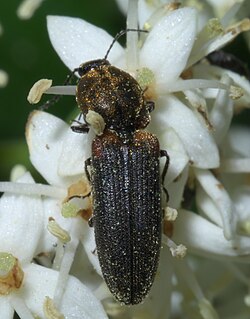| Limonius Temporal range: | |
|---|---|
 | |
| Limonius auripilis | |
| Scientific classification | |
| Domain: | Eukaryota |
| Kingdom: | Animalia |
| Phylum: | Arthropoda |
| Class: | Insecta |
| Order: | Coleoptera |
| Suborder: | Polyphaga |
| Infraorder: | Elateriformia |
| Family: | Elateridae |
| Subfamily: | Dendrometrinae |
| Genus: | Limonius Eschscholtz, 1829 |
| Synonyms | |
MicrathousLane, 1971 Contents | |
Limonius is a genus of click beetles in the family Elateridae. Many of the species formerly placed in this genus have been removed to other genera such as Gambrinus . [1]